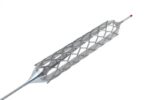Original title: New-generation drug-eluting stents reduce stent thrombosis and myocardial infarction: a propensity-score-adjusted analysis from the multicenter REAL registry. Reference: Vignali L et al. Cath Cardiovasc Interv. 2014; Epub ahead of print. Compared to the first generation of drug eluting stents (DES), the new generation has a lower long term risk of in-stent thrombosis and acute myocardial infarction...
PCI Superior to Optimal Medical Treatment in Patients with Ischemic Cardiomyopathy
Original title: Fractional Flow Reserve–Guided PCI for Stable Coronary Artery Disease. The FAME 2 Trial Investigators. Reference: Bernard De Bruyne et al. N Engl J Med 2014;371:1208-17. The FAME 2 and the COURAGE studies tested similar hypothesis, only in the first study PCI was guided by fractional flow reserve (FFR) in addition to an angiography. The study hypothesis...
Less Definite Thrombosis with Everolimus Eluting Stents
Original title: Three-Year Outcomes After Revascularization With Everolimus-and Sirulimus -Eluting Stents From the SORT OUT IV Trial. Reference: Lisette Okkels Jensen et al. J Am CollCardiolIntv, 2014;7: 840-8. Drug eluting stents (DES) have been shown to safely and effectively reduce restenosis compared to bare-metal stents. While the risk of thrombosis remains a matter of concern when it comes...
Direct Implantation of Drug Eluting Stents does not reduce restenosis
Original: Direct drug-eluting Stenting to reduce stent reestenosis (STRESSED). Reference: Wouter S. Remkes et al. J Am Coll Cardiol Intv, 2014;7: 751-8. Direct stenting, without predilation, has been considered a safe and effective technique that reduces procedural time, radiation exposure, contrast material and costs; however, the pertinent studies tested conventional stents only. This study aimed at assessing whether...
Less Bleeding at the Expense of a Higher Risk of Acute Thrombosis with Bivalirudin
Original title: Bivalirudin versus heparin in patients treated with percutaneous coronary Intervention: a meta-analysis of randomised trials. Reference: Salvatore Cassese et al. EuroIntervention 2014;10-online publish-ahead-of-print August 2014. Current recommendations for the use of bivalirudin in PCI patients are mostly based on studies comparing bivalirudin vs. heparin combined with glycoprotein IIb/IIIa inhibitors. Whether bivalirudin is superior to heparin alone...
Percutaneous Coronary Intervention to Unprotected Left Main Stem In Different Coronary Syndromes
Original title: Comparative Outcomes After Unprotected Left Main Stem Percutaneous Coronary Intervention: A National Linked Cohort Study of 5,065 Acute and Elective Cases From the BCIS Registry (British Cardiovascular Intervention Society). Reference: Sami S. Almudarra, et al. JACC Cardiovasc Interv 2014;7:717-30 Although myocardial revascularization surgery has long been the gold standard treatment for left main lesions, PCI has...
Thrombosis with bioresorbable scaffolds: the story of DES all over again?
Original title: Percutaneous coronary intervention with everolimus-eluting bioresorbable vascular scaffolds in routine clinical practice: early and midterm outcomes from the European multicentre GHOST-EU registry. Reference: Capodanno D et al. EuroIntervention. 2014 Jul 18. Epub ahead of print The GHOST-EU registry, that included 1189 patients from 10 European centers between 2011 and 2014, is now the largest registry...
Benefits at 5 years of routine invasive strategy in Non-ST-Elevation Acute Coronary Syndromes
Original title: Impact of an invasive strategy on five years outcomein men and women with Non-ST-Elevation Acute Coronary Syndromes. Reference: Joakim Alfredsson et al. Am Heart J. 2014;Epub ahead of print. This meta-analysis included patients with non-ST-elevation acute coronary syndrome (NSTE ACS) from randomized studies FRISC II, ICTUS and RITA 3 and compared the routine invasive strategy...
Superficial Femoral Artery In-Stent Restenosis with Drug Eluting Balloon: 2 Year Follow Up.
Original title: Drug-Eluting Balloons for the Treatment of the Superficial Femoral Artery In-Stent Restenosis. 2-Year Follow-Up. Reference: Vittorio Virga et al. J Am Coll Cardiol Intv 2014;7:411–5. Although the use of the self-expanding nitinol stent has improved angioplasty outcomes in femoropopliteal territory, restenosis remains a challenge still affecting at least 25% of the population in the first year....
SYNTAX study final monitoring at 5-years
Original title: Coronary artery bypass grafting vs. percutaneous coronary intervention for patients with three-vessel disease: final five-year follow-up of the SYNTAX trial. Reference: Eur Heart J. 2014 May 21. pii: ehu213. (Epub ahead of print). The SYNTAX study was one of the largest randomized clinical studies comparing long-term results of angioplasty versus surgery in multivessel disease and /or...









